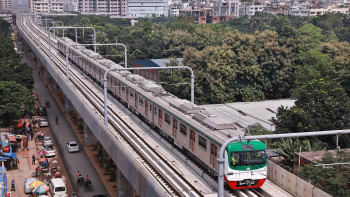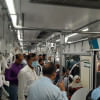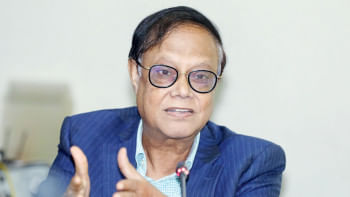The bittersweet dream of Dhaka’s metro rail

It may have been late 2017 or early 2018 when I first encountered a physical manifestation of the metro rail project in Dhaka. Leaving my part-time job at Mirpur 11 that evening, I realised that there were four-foot-high road dividers blocking my way to the other side of the busy main road. One of my co-workers, feisty as she was, simply climbed up onto the divider and stood on it for a bit before hopping down to the other side.
But my amusement and curiosity surrounding this megaproject soon turned to frustration and bitterness.
The incessant breaking up of Begum Rokeya Sarani, narrowing it down to barely one lane on each side, and the footpaths being walled off by even more dividers, did not really boast "development." Instead, everyone and their non-Mirpur acquaintances began bashing the area for being dusty and having broken roads that were quite impossible to drive on. But no one seemed to realise that Mirpur itself had never been the problem. Not that Mirpur was perfect before the metro rail construction began; still, it was, for the most part, liveable. But once the piers had dug their rods in, most of Mirpur truly turned into a dysfunctional stretch of impassable, unwalkable urban hellscape.
Over the next five or so years, the project took shape; the 16.2km viaduct and the hundreds of piers underneath it materialised. On the ground, we all began wearing face masks (yes, pre-Covid) to protect our lungs from construction debris. Going to work from my Mirpur 12 home, I used to feel guilty for "making" the rickshaw puller pedal his vehicle across the shattered asphalt (I wouldn't call it a "main road" at that point). Even the fares for auto-rickshaw trips along that road shot up considerably. The distance isn't much, but the state of the once-tolerable road slowed down all vehicles, almost doubling the duration of any commute.
In all this time, being eager about the metro rail experience was the furthest thing from my mind. I, like all locals, was too occupied with struggling to navigate what little "road" and "footpath" the construction of the Dhaka Mass Rapid Transit (MRT) Line-6 had left us with. There simply was no time to look up, and no scope to be excited at the prospect of something that might never even be actualised.
Of course, I have been proven wrong.
Most of the roads have been mended, some have even been widened, and the first instalment of the metro rail in our capital has been a reality for nearly seven months now. So, having tried and tested the service semi-thoroughly, I can finally convey a passenger's take on this latest mammoth addition to Bangladesh's public transport sector.
Of course, some ailments which exist in all our public transport are carried into the Dhaka metro rail, too. For example, there is the issue of male passengers boarding the all-female carriage. The first carriage of each train is reserved for women, with a sign at the platform pointing this out. Still, I have seen men knowingly or unknowingly boarding this carriage on all of my journeys. What is disappointing is that, after their error is pointed out, while some men scuttle into the next carriage (via the gangway doors), others outright refuse to leave. Even threats of being fined, courtesy of the train operator, fall on ears that have been deafened by an all-encompassing sense of entitlement.
Once you get to your nearest station, depending on your physical abilities, you can take the stairs, an escalator, or the lift up to the lobby. There, you can get a ticket to your destination from either the manned ticket counter or from one of the self-service ticketing machines. My favourite thing about the latter is that it provides you with change for your payment. Once you have your ticket, you can swipe it at one of the automated gates and make your way towards your platform (marked clearly by overhead signs). Here, too, you have the options of stairs, an escalator, and a lift to go up to the platform. The wait time for each train ranges between 5 and 15 minutes, depending on the time of the day. There are concrete benches available, but most passengers prefer to stand and wait in buzzing anticipation (I'm not exaggerating). Except for peak hours, the train doors usually stay open for around 10 seconds, within which all must exit or board the train.
As the train screeches along the rails, one cannot help but marvel at the experience of being a passenger on the Dhaka metro. The carriages are amply air-conditioned. And, even when standing up while holding loosely onto a handrail, one is guaranteed a non-turbulent journey. Before exiting the station at your destination through another set of automated gates, you will need to slip your single-use ticket into a slot, or swipe your multiple-use pass, to signal the end of your commute.
The first time I rode the metro, it took me around seven minutes to get from Pallabi to Agargaon. That's 6.4km in just as many minutes. Needless to say, I was all but converted to a fan of the Dhaka metro rail that day.
However, three key changes have been brought to the service since my first commute: 1) the train now stops at all of the stations between Uttara North and Agargaon; 2) it operates at night time, too, from 8am till 8pm; and 3) the weekly day-off has been switched from Tuesday to Friday. Since the beginning, and even now, many passengers (especially during off-peak hours) have viewed a commute on the metro rail as a family outing. While this is amusing to observe, I believe switching the off-day from a weekday to what is the weekly holiday for most people will help change this practice. The metro rail, after all, is an object of need – not of recreation.
The other two changes, however, have notably altered my initial contentment with the metro's service.
For one, the duration of my commute from Pallabi to Agargaon during the late morning has stretched significantly – from less than seven minutes to around 15 minutes or more (excluding wait time for the train). Waiting in line at the exit as people try to get through the three automated gates also adds to this time. And the situation gets even more challenging at night.
My first time using the service after sundown last week, I was shocked to find at least 200 people crowded in front of the ticket counter and machines at the Agargaon station. The heat was unbearable, of course, and so was the slowness of self-service as people are still getting used to the automated ticketing system. However, a couple of the ticket machines also began shutting down or restarting, adding to passengers' suffering, most of whom, like myself, were office-goers who were impatient to get home after a long and tiring workday. After finally acquiring my ticket (and one for a lady from another line, as the machine she was waiting to get to had broken down), I noticed that even the women's carriage, which is relatively unpopulated at other times, was packed. And, instead of the usual 10 seconds, the gates of the train remained open for a good few minutes.
All this made me realise that, given the increasing number of people using the metro rail, it is time for regular commuters to acquire multiple-use rapid passes. This will shorten the commute time for all passengers, as there will be fewer people crowding the ticket counters, and rapid pass holders can directly board trains as they arrive.
Of course, some ailments which exist in all our public transport are carried into the Dhaka metro rail, too. For example, there is the issue of male passengers boarding the all-female carriage. The first carriage of each train is reserved for women, with a sign at the platform pointing this out. Still, I have seen men knowingly or unknowingly boarding this carriage on all of my journeys. What is disappointing is that, after their error is pointed out, while some men scuttle into the next carriage (via the gangway doors), others outright refuse to leave. Even threats of being fined, courtesy of the train operator, fall on ears that have been deafened by an all-encompassing sense of entitlement.
Another issue which I hope the authorities will look into is the relatively high fare. For instance, one could easily take a hot, crowded, haphazardly-driven bus to their destination for a much lower fee than what the same distance would cost them on the metro – the comfort and swiftness of which may not be worth the price to many citizens. Ideally, in order to encourage the maximum number of people to use the train (and ultimately reduce traffic congestion on the roads), the fare for any given distance should be lower than what it would be on any other mode of transport.
There are, of course, many positives to outweigh the few negatives. Besides the aforementioned, there are also a good number of security personnel and other staff present across each station to not only prevent anything unsafe or untoward, but to also guide passengers through their commute. And, notwithstanding the horrible situation everywhere else in the city, the level of accessibility in the stations is decent enough.
All in all, it will still take some more changes before I fully warm up to the Dhaka metro rail – and can fully put behind myself the woes we all went through while the megaproject was heavily under construction. With the Agargaon-Motijheel link set to open in October, I remain eager to see how big of a positive impact the MRT-6 line can bring about for the otherwise dreadful daily commutes of the Dhakaites. I only hope we will never require professional "pushers" to fit passengers into metro rail carriages, like they do on Tokyo's subway trains.
Afia Jahin is a member of the editorial team at The Daily Star.

 For all latest news, follow The Daily Star's Google News channel.
For all latest news, follow The Daily Star's Google News channel. 










Comments